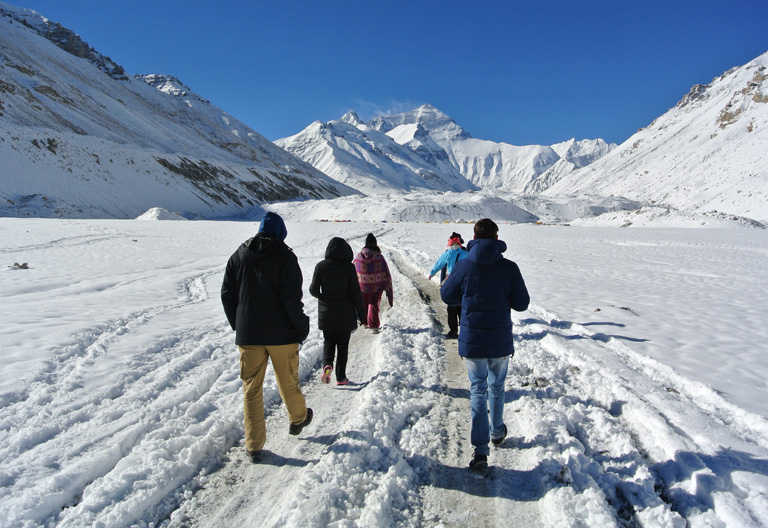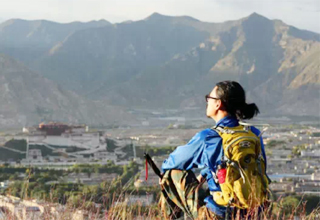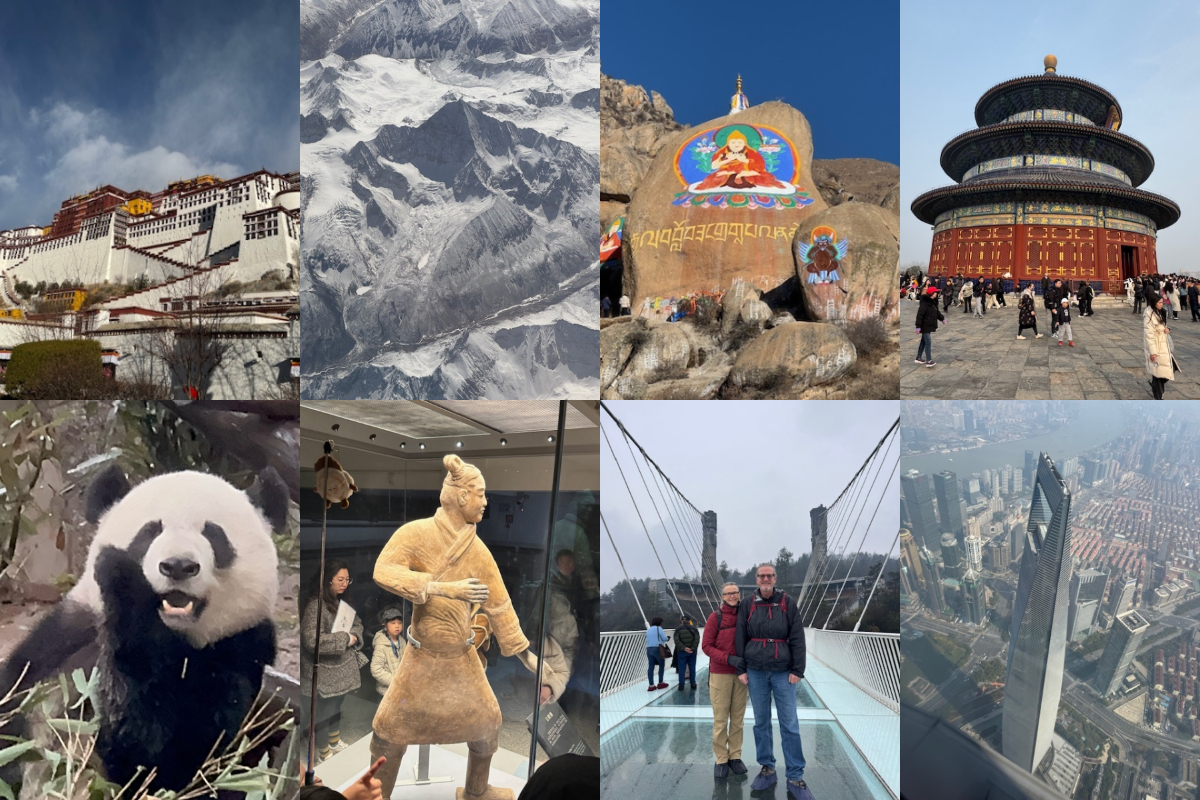The essence of this tour is the 4 days' trek from Tsurphu to Yangpachen. You will take the rugged path crossing beautiful mountains and valleys. The experience on the trek is great combination of alpine climbing, sweeping panoramic views of mountains and also visiting some featured monasteries. Besides the trek, you will also take several days visiting in Lhasa city not only exploring the famous attractions, but also preparing for the trek. Learn about Tibet culture and religion; Follow monk's life in monasteries; Trek around holy lake Namtso.
Highlights of this tour:
- Climb up the grandiose Potala Palace and visit sacred Buddhist temples and monasteries in Lhasa, such as Jokhang Temple, Drepung Monastery;
- Enjoy harsh but beautiful high plateau landscapes along the trekking from Tsurphu to Yangpachen;
- Go to explore the holy lake as well as one of the most beautiful lakes in China - Namtso Lake.
Tour Brief Information
- Tour price: from $1,517
- Tour code: TD-HT-10
- Tour Type: Escorted Private Tour
- Destination: Lhasa / Tsurphu / Yangpachen / Namtso / Lhasa
- Duration: 10 days and 9 nights
- Departure: You Choose!
- Travel Theme:


- Best Time:


- Physical Level
- Tour Pace
- Max Altitude
5,190m
- Itinerary Details
- Price Guide & Booking
- Trip FAQs
- Reviews
- Make an Enquiry
Your tour - at a glance
Day 1~4 Arrival & Lhasa Tour
Day 5~8 Trekking from Tsurphu Monastery to Yangpachen
Day 9 Namtso Lake - Lhasa
Day 10 Lhasa Departure
Itinerary Details - Day by Day
Day 1 Lhasa Arrival
Welcome to the roof of the world! You will be picked up by local tour guide at the airport hall or train station, and then be escorted to your hotel in Lhasa city in a private vehicle.
If your flight arrive at Lhasa early, you can take a short visit to the Nyethang Buddha which is coveniently located along the road to Lhasa. Built in more than 700 years ago, the Nietang Buddha is the largest and highest stone Buddha in Tibet, and was colorfully painted by deep colors of golden, red, blue and black. West not far from the Buddha is the Nyethang Monastery where the famous ancient Indian Buddhist master Atisha meditated and taught Buddhism.
After arrival at your hotel, the rest of the day is free for you to explore the local areas and acclimatize yourself to the air, temperature and high altitude of Lhasa.
High Altitude Acclimation Tips: 1) go for some leisure walking to acclimate the high altitude but avoid strenuous activity after arrival; 2) you’d better not have bath, in case of catching a cold; 3) drink more water, and have some fruit; 4) have a good rest.
Day 2 Lhasa ( B )
Start today’s Lhasa exploration with an exciting visit to the landmark - Potala Palace which is regarded as one of the most beautiful architectural building in the world. You will climb up the palace along the zigzag stone paths with white-and-red walls to the top of the palace where you can not only appreciate the exotic Tibetan-style architecture, but also get a great view of Lhasa’s urban areas, then walk into the inner space of Potala Palace to explore the stately chapels and learn about the history of the palace.
Continuing your exploration, you will then get to Jokhang Temple which is considered as the spiritual heart of Tibetan Buddhism. Each day, there are thousands of pilgrims coming from different places in Tibet to the temple to worship to the Buddha. This temple is also known as the “house of Buddha” because it keeps the precious Jowo Rinpoche, the life-sized (5 foot/1.5m) image of the Shakyamuni at the age of 12. The last site for today’s exploration is the famous Barkhor Street. It is a circular and wide street encircling the Jokhang Temple. The local people like to walk on the street for several circles usually in the late afternoon as a daily tradition of pilgrimage. The street also has many shops selling a wide variety of traditional Tibetan goods, religious items and handcrafts.
Tips of Today: 1) there are 1,080 steps up to climb to the top of Potala Palace, so don’t walk in a rush, which may cause high altitude sickness; 2) taking photos is not allowed inside the palace; 3) today you will be mainly outside, please bring some water, a hat, sun cream, and sun glasses with you.
-
 Great view of Potala Palace in the evening
Great view of Potala Palace in the evening
Day 3 Lhasa ( B )
After breakfast, you will firstly go to visit the beautiful Norbulingka which used to be the former summer palace of Dalai Lamas in the ancient time, and now is a public park. It is famous for its Potrang, the private palaces of former Dalai lamas with grandiose Tibetan architecture style. Next, drive several kilometers to the western outskirts of Lhasa to visit Drepung Monastery. Drepung, in Tibetan, means “prosperity”. Since its establishment, Drepung Monastery has always been one of the most important Buddhist monasteries in Tibet. In its heyday, there were more than 10,000 monks lived and studied in the monastery. Throughout its history, many important and famous Tibetan leaders used to study here, especially the Dalai Lamas. So Drepung Monastery is also respectfully known as the “Mother School of Dalai Lamas”.
In the afternoon, you will be taken to another famous monastery in Lhasa - Sera Monastery. It is famous for the spectacular “Buddhism Debating”. As a daily routine, the monks gather in a courtyard, and debate on the Buddhist doctrines with supplemented gestures, which is thought to be helpful to facilitates better comprehension of the Buddhist philosophy to attain higher levels of study. After enjoying the "Buddhism Debating", you will be transferred back to the city. The rest time is your own free time to rest.
The Etiquette of Visiting Monastery: 1) you shouldn’t wear short and uncover shoulders; 2) taking off your sunglasses and hat before entering the chapels; 3) taking photos is usually not allowed inside the chapels.
-
 Monks Gathered at the Entrance of Drepung Monastery
Monks Gathered at the Entrance of Drepung Monastery
Day 4 Lhasa to Tsurphu Monastery ( B )
After breakfast, you will be transferred about 70km from Lhasa city to Tsurphu where you will explore a unique monastery and prepare for your trekking next day. This Tsurphu Monastery to Yampachen trekking covers 55 kilometers and will be done in 4 days.
Tsurphu Monastery (4500m) is the seat of Karma branch of Kagyu sect of Tibetan Buddhism. It was built by the founder of Karma Kagyu Sect in 1187 whose birthplace is Kham in Sichuan Province. Karmapa is the leader or abbot of Karma Kagyu. There have already had 17 Karmapas ruled in the Tsurphu Monastery since 12th century.
Day 5 Trek from Tsurphu to Leten ( B, L , D )
Trek: 3-4 hours, 11km
Today’s trek begins by heading west or up the valley. You’ll pass some nomad tents and valley junction. Leten is also called the “highest village in the world”, several families live here permanently, braving the severe climate with their livestock.
Day 6 Trek from Leten to Bartso ( B, L, D )
Trek: 5-6 hours, 15km
Today you’ll reach the highest pass of this trekking – Lasar La, so getting refresh is very important.
It will cost 3 hrs from Leten to Lasar-la. Then another 3 hours walk to Bartso. This nomad village of 5 homes with a permanent source of water is a good place to camp.
Day 7 Trek from Bartso to Dorjeling Nunnery ( B, L, D )
Trek: 5 hours, 18km
Look northwest from Bartso to the opposite side of the valley. Clearly visible, a wide trail winds up from the valley to the top of the ridge. Ford the valley stream and make for this trail, 25 minutes' walk over marshy ground from Bartso. It is another half-hour to the summit of the ridge. From the top you'll see a sallde north of an intervening valley. On the far side of this saddle is Dorjeling Nunnery.
Day 8 Trek from Norjeling Nunnery to Yangpachen ( B, L, D )
First, you will use 1 hour reach the large river of the Lhorong Ma Chu. Another 3 hrs walk to Yangpachen Monastery. It is a 15km road journey to Yangpachen. The hot-spring here,7km west of Yangpachen, is great to ease your aching limb.
Day 9 Namtso Lake, Lhasa ( B, L )
Today, you will be taken to have an exciting trip to the holy lake Namtso. After arrival at the lakeshore, take some rest and throw yourself into the incredible landscape of holy lake.
Namtso Lake is the highest saltwater lake in the world with an altitude of 4718 meters, also the second largest saltwater lake in China (after the Qinghai Lake). It’s quite common for tourists who are awestruck at the Namtso at the first sight. With the snowy mountains in the background, the crystal-clear dazzling blue water, Namtso is stretching to the horizon. There is no wonder why it was called “Heavenly Lake”. With hundreds of colored prayer flags, attached to the rugged, spiked cliffs facing the lake, Namtso seems more than just a scenic spot. The sound of prayer wheel, fluttered in the strong wind to remind its holiness.
After sightseeing, drive back to Lhasa.
-
 Flags fly along Namtso Lake
Flags fly along Namtso Lake
Day 10 Lhasa Departure ( B )
Today is free for you until your tour guide transfer you to the airport in time for your flight or drop you off at Lhasa train station.
Tips of today: 1. Please pack your luggage carefully, especially for small things like camera charger, power adaptor, mobile phone, phone charger, wallet and towel. 2. If your flight is arranged in the afternoon, please make sure you check out the hotel before 12pm.
Useful Trip Notes
-
- 1. Tibet Permits Guaranteed
To travel in Tibet, all Non-Chinese passport holders need to have a Tibet Travel Permit which is issued by Tibet Tourism Bureau in Lhasa. And only Chinese travel agencies like Tibet Discovery can apply for the permit on behalf of tourists. You must obtain it before your tour starting because the permit will be checked when you board your flight/train to Tibet. Traveling with Tibet Discovery, you don't have to worry about the complicated procedures of Tibet Travel Permit application. All you have to do is to confirm a tour package with us and send us your passport and Chinese visa copies at least 15~20 days in advance before your tour, then we will take care of all the rest things. Once the permit is issued, we will deliver to your address in China, such as your hotel, local travel agency, etc.
-
- 2. Available Months to Visit Tibet
Generally speaking, April to October is the best time. July and August are the peak season and rainy season. It is usually snowy and cold in winter, which is not suitable for visit Mount Everest, Namtso and Mount Kailash regions. While other places such as Lhasa, Gyantse and Shigatse are suitable for travel all year around. The temperatures in daytime and night differs a lot, usually 5~15℃ in the daytime and -5~0℃ in the night, so please wear accordingly.
-
- 3. High Altitude Sickness
The average altitude of Tibet is about 4000 meters above the sea level (Lhasa: 3700m; EBC: 5200m; Namtso: 4718m). You may suffer a bit from High Altitude Sickness in the beginning days of your Tibet trip if you haven’t had rich high plateau travel experience. But don’t worry too much, the high altitude can be acclimatized usually in 2~3 days. Our suggestion is to take a physical examination and get suggestions from your doctor, and also bring some medicines to prevent from High Altitude Sickness before your trip. While in Tibet, you should keep warm all the time, avoid strenuous activities, drink more water and eat more vegetables and carbohydrates. You’d better not take showers during the first two days after your arrival in Tibet. If you don’t feel well, get help from your tour guide or go to the hospital without any delay.
-
- 4. How to Go to Tibet
Basically you have two options – flight and train. Currently, you can take a flight to Lhasa from Beijing(4.5hrs), Xian(3.7hrs), Chengdu(2.5hrs), Chongqing(3hrs), Kunming(3hrs), Kathmandu (1.5hrs), etc. Among all these cities, Chengdu and Xian have more frequent flights to Lhasa.
If you prefer a train travel, you can take a train to Tibet from Beijing(40.5hrs), Xian(32hrs), Chengdu(43hrs), Shanghai(47hrs), Chongqing(42hrs), Lanzhou(25hrs), Xining(22hrs), Guangzhou(54hrs). -
- 5. Packing and Wearing Ideas
Firstly you can’t forget your passport and Chinese Visa. A large backpack and a smaller one are recommended (the smaller one can be used for daily activities). Also bring necessary medicine you need. Other stuffs like sunglasses, snow glasses, hats, lip balm, sun block are recommended.
As for wearing, you are suggested to dress in layers (both thin and thick jackets). Down jacket is necessary in Spring and Autumn. A pair of durable and comfortable shoes is necessary.
Recommended Tibet Group Tour Packages
Escorted by a skilled driver and companied by a professional local tour guide to organize all the activities, all you have to do is to enjoy your fantastic Tibet journey.Following are some other recommended Tibet group tour packages that you may be interested in. You can also contact us to customize a trip if you want..
-

Lhasa / Gyantse / Shigatse / Everest / Lhasa
8 Days Lhasa to Mount Everest Private Tour
Highlights: Potala Palace, Yamdrok Lake, Tashilhunpo Monastery, Mt. Everest
-

Lhasa / Gyantse / Shigatse / Old Tingri / Everest Base Camp / Lhasa
12 Days Everest Base Camp Trekking Tour
Highlights: Trekking to Everest Base Camp, Yamdrok Lake, Palcho Monastery, Potala Palace
-

Lhasa city and suburb
5 Days Lhasa Leisure Hiking Tour
Highlights: Potala Palace, Jokhang Temple, Mountain Hiking












 Karen
Karen Wonder
Wonder Jack
Jack Rita
Rita Johnson
Johnson Vivien
Vivien Wing
Wing Ariel
Ariel Leo
Leo Tracy
Tracy Evelyn
Evelyn April
April Phoebe
Phoebe Kelly
Kelly Shirley
Shirley Reya
Reya Juliet
Juliet Elk
Elk Felix
Felix Sean
Sean